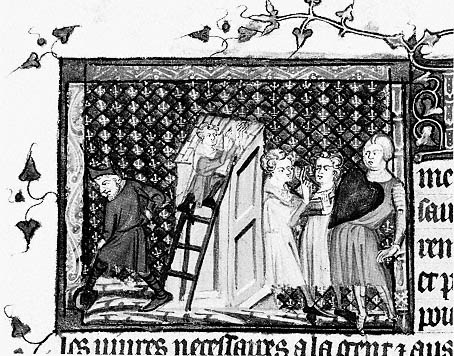Costumes and Attributes
As in previous illustrations, costumes and attributes differentiate one class from another and relate the institutions discussed by Aristotle to those of contemporary society. A precedent for such a representation occurs in a miniature of the Morgan Avis au roys (Fig. 76) illustrating four classes necessary for the support of a kingdom. From left to right are depicted an agricultural worker, a craftsman roofing a house, and the learned professions represented by two men conversing and a man-at-arms. No distinction is made, however, about their respective political status.
In Figures 74 and 75 clear articulation of the citizen groups is particularly important for both generic and specific visual definitions. In this process certain important revisions occur between Figures 74 and 75. For example, the gent d'armes in Figure 74 wear civilian, knee-length, belted jackets and carry swords and spears. Their weapons, upright postures, and hand gestures identify their function as potential defenders of the cité : in modern terms, reservists rather than professional soldiers. In Figure 75, however, the gent d'armes make up an organized fighting force. Their armor, helmets, and weapons (including a crossbow) emphasize that they are a professional army. The gent de conseil of Figure 74 also differ from the equivalent group in Figure 75. The former comprises three standing figures, who may be exercising a deliberative function. The one on the right wears the distinctive domed hat associated with the rich class in the illustrations of Book

Figure 76
The Classes Necessary to the Realm. Avis au roys.
IV (Figs. 64 and 65). The other three figures are seated on a bench in earnest discussion. Previous illustrations, particularly the frontispieces (Figs. 46–49), suggest that the bench signifies a judicial or legal function. Figure 75 makes these roles more explicit. Two figures at the left stand next to a larger group seated on a bench. The two ermine strips on the mantle of the first standing figure identify him as a member of the royal family.[31] His deliberation with the figure facing him abuts the legal or judicial activities of the larger group. The connection between the two groups reveals the dual function of this class. The gent sacerdotal also undergo a change in identity. In Figure 74, the tonsures and brown robes of the figures at the extreme left and right indicate members of monastic orders. Only the cleric wearing the black rectangular headdress is distinguished in rank from the rest. In contrast, high ecclesiastical rank is emphasized in Figure 75, where two full-length bishops predominate and a third is partially visible among the background figures.
Fewer changes between Figures 74 and 75 take place among the noncitizen groups. Two of them are identical to the poor class of Book IV (Figs. 64 and 65). With the addition of one figure and a slight variation of implements, the povres of Bonne policie reappear as the cultiveurs de terres of Book VII in the upper register of Figure 74 and the central zone of Figure 75. Similarly, the three povres of Mau-
vaise policie in Figures 64 and 65 materialize as the genz de mestier in Figures 74 and 75. The former adds one figure; the latter, two. Except for the blacksmith, in both series this class is associated with the building trades. Particularly striking is the change in the appearance of the genz de mestier . Whereas the three figures in Figure 74 project an innocent appearance as they casually display the tools of their trade, their rigidly lined-up counterparts in Figure 75 seem to wield their firmly gripped implements as weapons. Rather than the rich in the Book IV illustrations, the marcheans of Book VII bear some resemblance to the pair represented in Book VIII of the Ethiques (Fig. 38). In both Figures 74 and 75, however, two pairs of merchants are depicted in separate exchanges. The man on the right of the first pair pays for a garment he purchases, while the pair in Figure 74 shake hands on a transaction involving two pigs. Their counterparts in Figure 75, however, add a third member, and the animals involved in the exchange are two sheep. The alterations made in Figure 75 pointedly refer to transactions in the wool trade.